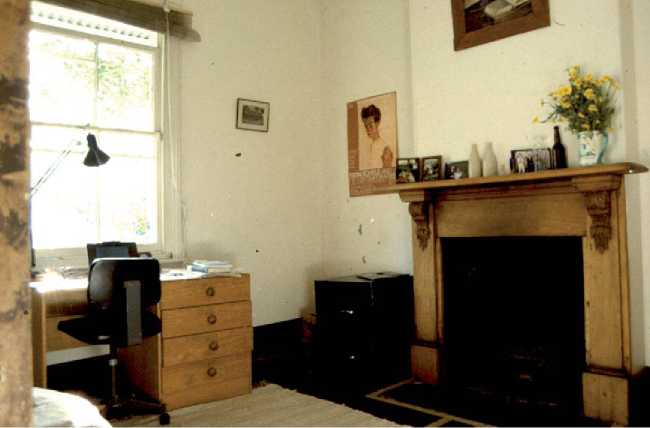Households do not just live in houses, they also use material culture. While it is true that archaeologists do not dig up households, it is also true that they do not dig up just houses. Whenever they dig settlement sites, they invariably dig up household material culture. The structural remains are only part of that material culture. As ethnography and history can serve to flesh out these remains, it can warn us that architecture can conceal household behavior. For example, the home office in my nineteenth-century terrace house in Sydney was originally constructed as a parlor (Figure 2). This changed use of space, and the changed internal dynamics of a household, did not involve any structural change to the house. Archaeologists digging up such a house would not be able to identify this reuse through the floor plan alone. They would need to pay close attention to the distribution patterns of the house contents that might have fallen through the wooden floor boards (e. g., paper clips and parts of pens), what Amos Rapoport termed the ‘non-fixed-feature’ elements. There is often a considerable wealth of such elements in archaeological remains - pottery and glass vessels, stone, metal and worked bone implements, animal bones, vegetal remains - which are not part of the house structure, but which are evidently part of the household and which provide insights into the nature and distribution of household activities, and into relationships between social action and material culture.
Studies of house floor assemblages for assessing spatial distribution of household activities had their beginnings in the southwestern United States in the 1970s (see Americas, North: American Southwest, Four Corners Region). However, the rich data sets and the documentary evidence from other parts of the world, particularly from Old World sites in the Mediterranean region, are well suited to this type of investigation. Many recent studies in Old World archaeology have investigated the distribution of household artifacts within dwelling spaces. Through analyses of all the material culture of past households we can learn much about past household behavior.
However, it is by no means a simple matter to identify the contents of a house, or more particularly of a room, in the archaeological record, because the depositional processes which occur during habitation - change of habitation, abandonment, and postabandonment - contribute to the house floor assemblages excavated by archaeologists. These depositional processes need to be carefully identified in the archaeological record, and relationships between the different assemblages and structural remains identified, before artifact assemblages can be used to study household behavior. Thus, the state of preservation of a site is a major factor in the success of such an approach.
Choice of Site
House floor assemblages, as found on archaeological sites, are a palimpsest of activities that may cover several generations - the materialization of the ‘household series’ mentioned above. However, sites that were rapidly and completely abandoned are more likely to present house floor assemblages belonging to the final occupancy of that site. The New Archaeologists considered Pompeii to be the archetypal site for such ‘systemic house floor assemblages’, but even there the depositional processes are much more complex than widely believed. The Classic period Ceren site in El Salvador was also destroyed by a volcanic eruption c. CE 500-680, but it was

Figure 2 Twentieth-century home office in nineteenth-century parlor in Sydney, Australia. © 2008 Dr Penelope Allison. Published by Elsevier Inc. All rights reserved.
Excavated by more modern techniques than Pompeii and so has better identified house floor assemblages. Sites that have suffered a human rather than a natural catastrophe can also provide good data for studying household behavior. The ancient Greek cities of Haleis and Olynthus were rapidly abandoned during political upheaval, leaving a wealth of archaeological remains. Failure to strike gold, or other desirable mineral resources, in mining settlements in both the ancient and modern worlds, often results in short-term occupation followed by swift abandonment. The destruction and rapid abandonment of military or frontier sites can also provide useful evidence of household activity in often tenuous and unstable conditions. Thus, the ideal sites for using artifact assemblages to investigate for patterns of household activities, and therefore household behaviors in a particular community, are those sites with relatively well-preserved house floor assemblages. However, such sites can still display a range of patterns of reuse and discard which must be considered when using artifacts and their related activities to describe spatial functions within household contexts.
Equally, investigations of household archaeology are not limited to such ideal sites. It is possible to investigate a particular household activity at less well-preserved sites on a site-wide basis, comparing it with other sites that are culturally or chronologically related. Analyses of the artifact assemblages in refuse locations in both rural and urban sites can provide information for intersite comparisons of household behavior. For example, insights into varying dietary behavior between the late Iron Age and early Roman periods in Britain, or into the changing diets of colonists as they come to terms with the environment and the isolation, can be gained by comparing assemblages of animal bone from a number of different sites.
Thus, analyses of artifact distribution at archaeological sites play an important role in household archaeology by contributing less prescriptive approaches to the distribution of household activities than studies that rely on the structural remains. The use of computerized databases and statistical analyses has greatly facilitated such approaches to household material culture. The study of household activities requires a ‘rich’ description of all domestic remains. Electronic data collection and analyses allow archaeologists to process large amounts of data, rapidly and from a range of perspectives.




 World History
World History









